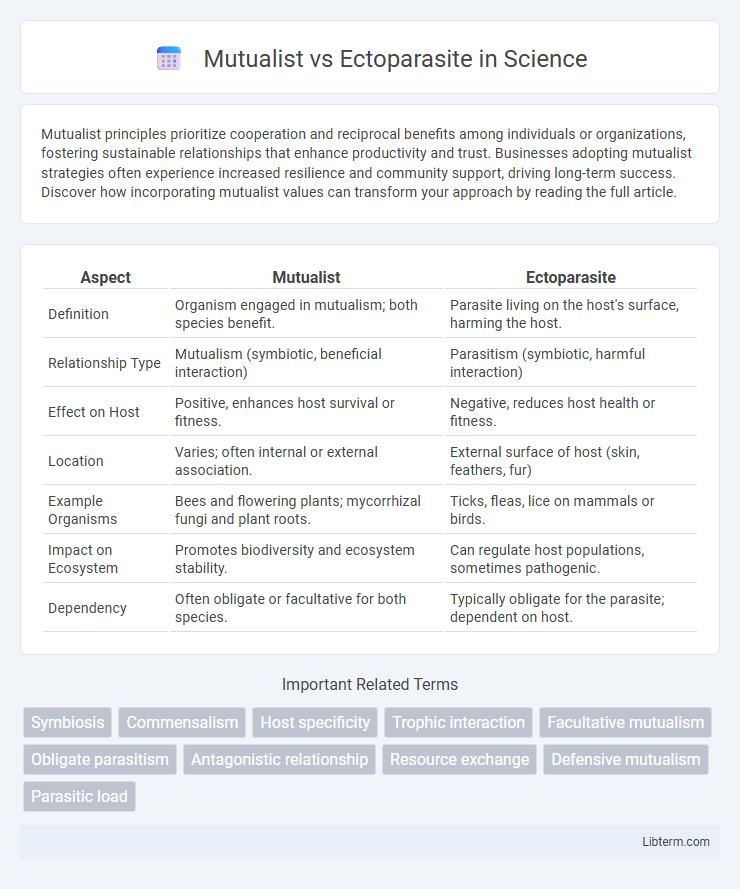Mutualist principles prioritize cooperation and reciprocal benefits among individuals or organizations, fostering sustainable relationships that enhance productivity and trust. Businesses adopting mutualist strategies often experience increased resilience and community support, driving long-term success. Discover how incorporating mutualist values can transform your approach by reading the full article.
Table of Comparison
| Aspect | Mutualist | Ectoparasite |
|---|---|---|
| Definition | Organism engaged in mutualism; both species benefit. | Parasite living on the host's surface, harming the host. |
| Relationship Type | Mutualism (symbiotic, beneficial interaction) | Parasitism (symbiotic, harmful interaction) |
| Effect on Host | Positive, enhances host survival or fitness. | Negative, reduces host health or fitness. |
| Location | Varies; often internal or external association. | External surface of host (skin, feathers, fur) |
| Example Organisms | Bees and flowering plants; mycorrhizal fungi and plant roots. | Ticks, fleas, lice on mammals or birds. |
| Impact on Ecosystem | Promotes biodiversity and ecosystem stability. | Can regulate host populations, sometimes pathogenic. |
| Dependency | Often obligate or facultative for both species. | Typically obligate for the parasite; dependent on host. |
Introduction to Symbiotic Relationships
Mutualist and ectoparasite represent two distinct types of symbiotic relationships where organisms live in close association. Mutualists engage in interactions that benefit both species involved, such as pollinators and flowering plants enhancing reproduction and nutrient exchange. Ectoparasites, like lice on mammals, derive nutrients at the host's expense, often causing harm while residing on the external surface of their host.
Defining Mutualists
Mutualists are organisms that engage in symbiotic relationships where both parties benefit, promoting survival and reproductive success. These interactions contrast with ectoparasites, which live on the surface of a host and derive nutrients at the host's expense, often causing harm. Mutualistic relationships are characterized by reciprocal exchanges of resources or services, such as nutrient sharing between mycorrhizal fungi and plant roots.
Understanding Ectoparasites
Ectoparasites are organisms that live on the surface of a host, deriving nutrients at the host's expense without providing any benefit, often causing harm such as irritation, blood loss, or disease transmission. Common examples of ectoparasites include ticks, fleas, and lice, which exploit their hosts for survival while negatively impacting their health. Understanding ectoparasite behavior, life cycles, and host interactions is essential for developing effective control measures in both human and veterinary medicine.
Key Differences Between Mutualism and Parasitism
Mutualism involves a symbiotic relationship where both species benefit, such as bees pollinating flowers while obtaining nectar. Ectoparasitism occurs when one organism, like ticks, lives on the surface of a host, deriving nutrients at the host's expense without providing benefits. Key differences between mutualism and parasitism include the direction of benefit, presence of harm to the host, and the ecological roles each relationship plays in ecosystems.
Examples of Mutualist Interactions
Mutualist interactions occur when both species benefit, such as the relationship between bees and flowering plants, where bees obtain nectar while pollinating flowers. Another example involves clownfish and sea anemones, where clownfish receive protection from predators, while anemones gain cleaning services. The interaction between nitrogen-fixing bacteria in legume root nodules and their host plants improves soil fertility and plant growth, exemplifying a classic mutualist symbiosis.
Common Ectoparasite Species
Common ectoparasite species include fleas, ticks, lice, and mites, which feed on the external surface of their hosts, often causing irritation and transmitting diseases. Unlike mutualists that provide benefits to their hosts, such as gut bacteria aiding digestion, ectoparasites primarily extract nutrients at the host's expense. These parasites are prevalent across mammals, birds, and reptiles, and are significant vectors for pathogens like Lyme disease and typhus.
Ecological Impacts of Mutualists
Mutualists enhance ecosystem stability by promoting biodiversity and resource availability through positive interactions, such as pollination and nutrient cycling. Their ecological impacts include increased plant reproduction rates and improved soil fertility, which support diverse food webs and habitat complexity. These interactions strengthen resilience against environmental stressors and contribute to ecosystem productivity and balance.
Effects of Ectoparasites on Hosts
Ectoparasites, such as ticks and lice, negatively impact hosts by causing blood loss, skin irritation, and transmitting diseases like Lyme disease and typhus. These parasites can lead to decreased host fitness, anemia, and increased susceptibility to secondary infections, significantly impairing the host's health and reproductive success. Unlike mutualists that provide benefits, ectoparasites primarily extract resources at the host's expense, often resulting in weakened immune responses and behavioral changes in the host.
Evolutionary Perspectives on Symbiosis
Mutualists and ectoparasites represent contrasting evolutionary strategies in symbiosis, with mutualists providing reciprocal benefits that enhance the fitness of both partners, while ectoparasites exploit their hosts, often reducing host fitness. Evolutionary perspectives highlight that mutualism can evolve from parasitism through coevolutionary adaptations that increase cooperation and resource exchange, leading to mutual dependence. The dynamic balance between conflict and cooperation shapes the genetic and ecological frameworks driving the diversification and stability of these symbiotic relationships.
Mutualist vs Ectoparasite: Implications for Biodiversity
Mutualists enhance biodiversity by promoting species interactions that improve ecosystem stability, nutrient cycling, and habitat complexity, while ectoparasites tend to reduce host fitness, influencing population dynamics and potentially driving host species adaptation or decline. The balance between mutualistic benefits and ectoparasitic costs shapes community structures, affecting overall species richness and ecological resilience. Understanding these contrasting relationships aids conservation strategies by highlighting the roles of biotic interactions in maintaining or disrupting biodiversity.
Mutualist Infographic

 libterm.com
libterm.com